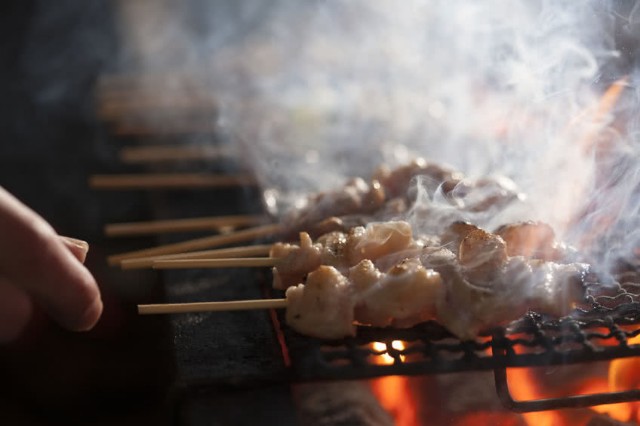Skewered foods, known as kushiyaki, feature delectable bites of meat and vegetables that go perfectly with beer or sake. “Kushi” refers to the bamboo skewers used to spear the ingredients, while “yaki” means grilled or fried.
Eating grilled meat on sticks is a Japanese tradition that dates back to at least the 17th century. Although for some time eating meat was forbidden in Japan due to Buddhist conventions, during the Meiji period of modernization people began to eat meat again and shops specializing in grilled meat on skewers took off. In the period between WWI and WWII, the battered and deep-fried skewers known as kushiage or kushikatsu also became popular. Today, both grilled and fried kushiyaki can be savored with all kinds of meat and vegetables.
Types of Kushiyaki
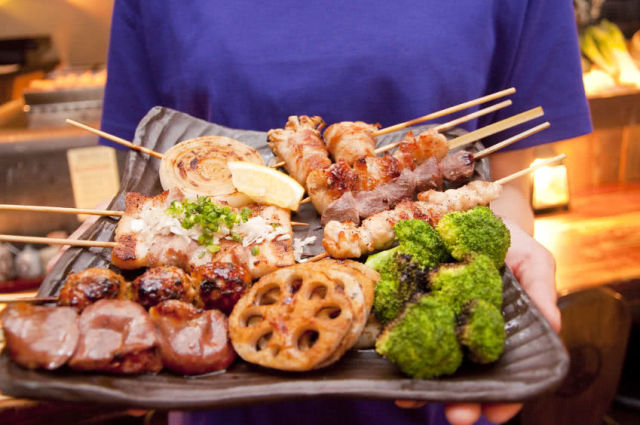 The oldest and most common type of kushiyaki is yakitori, or grilled chicken skewers. Yakitori features various parts sourced from the entire chicken. Similar to yakitori is yakiton, or grilled pork skewers, upon which both common and unusual cuts of pork are cooked over a charcoal flame.In addition to grilled skewers, there are also kushiage fried skewers made with bites of meat, vegetables, and even cheese that have been skewered, breaded in flaky panko breadcrumbs, and deep-fried. Each skewer is served up piping hot and eaten with a thick and sweet dipping sauce from a large communal pot. The dish first originated in the western Kansai region, but today is eaten all over Japan. The name “kushiage,” which means “deep-fried skewers,” is more common around Kansai, but in other parts of Japan the same food may be referred to as kushikatsu, meaning skewers of katsu (deep-fried cutlets), because the breaded and deep-fried skewers are similar to chicken katsu and tonkatsu pork cutlets.Browse tonkatsu restaurants in Japan
The oldest and most common type of kushiyaki is yakitori, or grilled chicken skewers. Yakitori features various parts sourced from the entire chicken. Similar to yakitori is yakiton, or grilled pork skewers, upon which both common and unusual cuts of pork are cooked over a charcoal flame.In addition to grilled skewers, there are also kushiage fried skewers made with bites of meat, vegetables, and even cheese that have been skewered, breaded in flaky panko breadcrumbs, and deep-fried. Each skewer is served up piping hot and eaten with a thick and sweet dipping sauce from a large communal pot. The dish first originated in the western Kansai region, but today is eaten all over Japan. The name “kushiage,” which means “deep-fried skewers,” is more common around Kansai, but in other parts of Japan the same food may be referred to as kushikatsu, meaning skewers of katsu (deep-fried cutlets), because the breaded and deep-fried skewers are similar to chicken katsu and tonkatsu pork cutlets.Browse tonkatsu restaurants in Japan Kushiyaki Ingredients
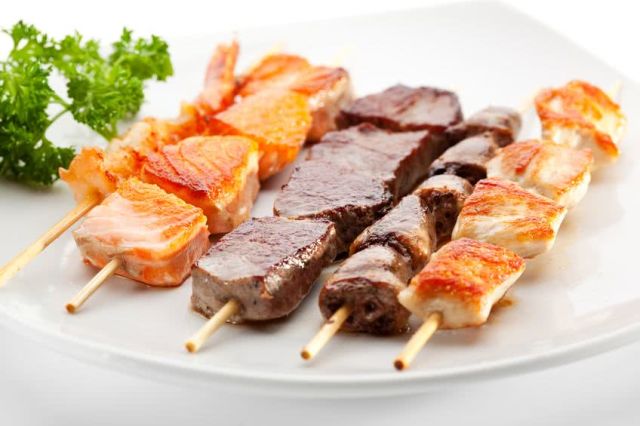 Any food that can be skewered may be served for kushiyaki. For chicken skewers, common offerings include sasami (chicken breast fillet) and tsukune (chicken meatballs), while more uncommon morsels include chicken hearts, tail, and even chicken combs. For pork skewers, buta bara (pork belly) and negima (pork with leek) are some of the most popular offerings, but there are plenty of unusual options like kashira (pork jowl), shiro (intestine), and pork liver. Beef skewers include juicy cuts of steak and thinly sliced gyutan (beef tongue).
Any food that can be skewered may be served for kushiyaki. For chicken skewers, common offerings include sasami (chicken breast fillet) and tsukune (chicken meatballs), while more uncommon morsels include chicken hearts, tail, and even chicken combs. For pork skewers, buta bara (pork belly) and negima (pork with leek) are some of the most popular offerings, but there are plenty of unusual options like kashira (pork jowl), shiro (intestine), and pork liver. Beef skewers include juicy cuts of steak and thinly sliced gyutan (beef tongue).In addition to meat, there are plenty of seafood offerings such as fish fillets, squid, shrimp, octopus, and scallops. Practically any vegetables, such as shishito (Japanese green pepper), onions, shiitake mushrooms, bacon-wrapped cherry tomatoes, and even items like cheese and avocado can be skewered and served kushiyaki-style.Browse yakitori restaurants in Japan
Kushiyaki Sauce
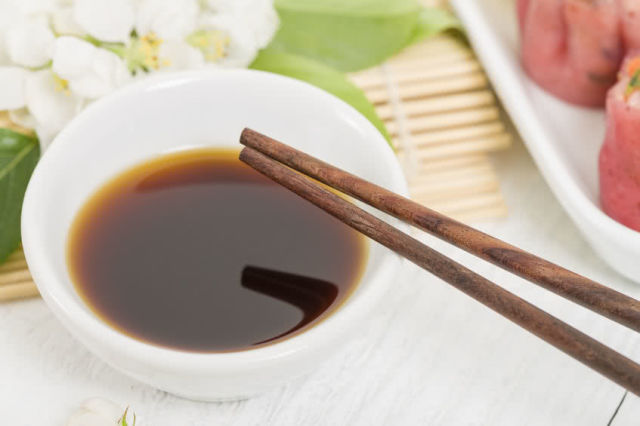 Yakitori and yakiton may be seasoned with either shio (salt) or tare (a sweet soy sauce-based dipping sauce) before serving. While no further seasoning is usually required, skewers may be eaten with togarashi chili pepper, sansho pepper, and yuzu-kosho (a condiment made from yuzu citrus ground together with salt and green chilies). Grilled chicken breast is sometimes also served with freshly grated wasabi.Browse yakiton restaurants in Japan
Yakitori and yakiton may be seasoned with either shio (salt) or tare (a sweet soy sauce-based dipping sauce) before serving. While no further seasoning is usually required, skewers may be eaten with togarashi chili pepper, sansho pepper, and yuzu-kosho (a condiment made from yuzu citrus ground together with salt and green chilies). Grilled chicken breast is sometimes also served with freshly grated wasabi.Browse yakiton restaurants in JapanPopular Things to Eat with Kushiyaki
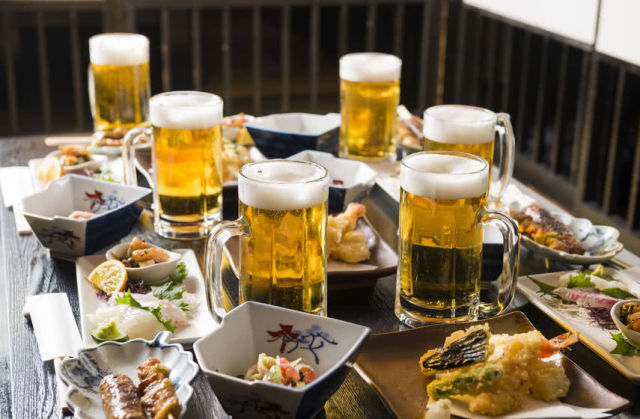 Kushiyaki is popular with beer and sake. Other side dishes may include izakaya staples like edamame (steamed soybean pods), tsukemono pickles, tamagoyaki (sweet rolled omelet), potato salad, and hiyayakko (chilled tofu salad). In addition, fried kushiage skewers are typically served with large pieces of raw cabbage to refresh the palate between bites of deep-fried foods. Eat them with a squeeze of lemon or dip them into the thick kushiage dipping sauce.Browse beer and sake bars in Japan
Kushiyaki is popular with beer and sake. Other side dishes may include izakaya staples like edamame (steamed soybean pods), tsukemono pickles, tamagoyaki (sweet rolled omelet), potato salad, and hiyayakko (chilled tofu salad). In addition, fried kushiage skewers are typically served with large pieces of raw cabbage to refresh the palate between bites of deep-fried foods. Eat them with a squeeze of lemon or dip them into the thick kushiage dipping sauce.Browse beer and sake bars in JapanWhere to Eat Kushiyaki
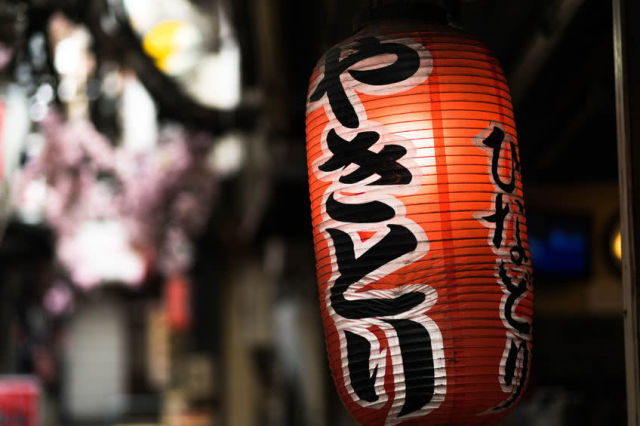 Kushiyaki can be enjoyed at a wide variety of eateries. Yakitori and yakiton, in particular, can be found at most Japanese establishments with a grill including izakaya, tachinomi (standing) bars, wine bars, pubs, seafood restaurants, and of course yakitori and yakiton specialty restaurants. Specialty shops may focus on a single type of kushiyaki, such as chicken or pork only, but a general kushiyaki restaurant will offer a wide variety of meats and vegetables. Deep-fried kushiage is not as widely available as grilled skewers because it requires a separate deep fryer set-up, but there are plenty of kushiage specialty shops to be found especially in the Shin-Sekai area of Osaka.
Kushiyaki can be enjoyed at a wide variety of eateries. Yakitori and yakiton, in particular, can be found at most Japanese establishments with a grill including izakaya, tachinomi (standing) bars, wine bars, pubs, seafood restaurants, and of course yakitori and yakiton specialty restaurants. Specialty shops may focus on a single type of kushiyaki, such as chicken or pork only, but a general kushiyaki restaurant will offer a wide variety of meats and vegetables. Deep-fried kushiage is not as widely available as grilled skewers because it requires a separate deep fryer set-up, but there are plenty of kushiage specialty shops to be found especially in the Shin-Sekai area of Osaka.Kushiyaki Etiquette
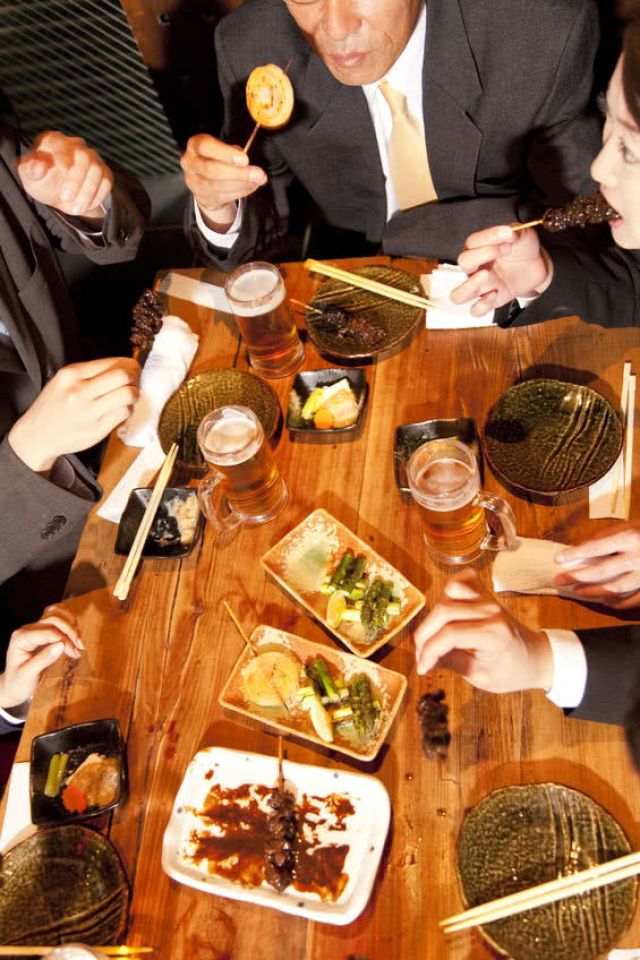 Kushiyaki can be ordered as a set or skewer by skewer. When ordering, the waiter will ask whether you prefer shio (salt) or tare (sauce) for the seasoning. For shio, salt is sprinkled onto the skewers as they are grilled, while for tare, the grilled skewer is dipped into tare sauce after cooking and then served. While the choice is a matter of personal preference, shio is a good option for those who want to taste the true flavor of the ingredients, while a good tare sauce can add an extra layer of flavor to meat.Especially for deep-fried kushiage, there is an additional rule to watch out for: No double-dipping the sauce. Most kushiage restaurants will have a sign that clearly warns against double-dipping, so make sure to dip the freshly fried skewer into the communal dipping sauce only once. Those who require extra sauce can use a piece of raw cabbage to scoop out more.After eating kushiyaki, the used skewers should be discarded in the small cylindrical container that is usually found on the table.Browse more articles on Japanese dining etiquette
Kushiyaki can be ordered as a set or skewer by skewer. When ordering, the waiter will ask whether you prefer shio (salt) or tare (sauce) for the seasoning. For shio, salt is sprinkled onto the skewers as they are grilled, while for tare, the grilled skewer is dipped into tare sauce after cooking and then served. While the choice is a matter of personal preference, shio is a good option for those who want to taste the true flavor of the ingredients, while a good tare sauce can add an extra layer of flavor to meat.Especially for deep-fried kushiage, there is an additional rule to watch out for: No double-dipping the sauce. Most kushiage restaurants will have a sign that clearly warns against double-dipping, so make sure to dip the freshly fried skewer into the communal dipping sauce only once. Those who require extra sauce can use a piece of raw cabbage to scoop out more.After eating kushiyaki, the used skewers should be discarded in the small cylindrical container that is usually found on the table.Browse more articles on Japanese dining etiquette Japanese Skewers are Simply Delicious
Kushiyaki options run a delectable gamut from deep-fried options to healthier grilled delights. For a detailed list of places to experience kushiyaki throughout Japan, explore the great dining options on Savor Japan. And don’t stop there—expand your palate with other restaurants in this awesome epicurean center.Discover more Kushiyaki restaurants by area
Tokyo Area Near Tokyo Kyoto and Osaka Area Hokkaido Area Northern Honshu (Tohoku) Central Honshu (Chubu) Western Honshu (Chugoku) Shikoku Kyushu Okinawa and Southeast Islands


